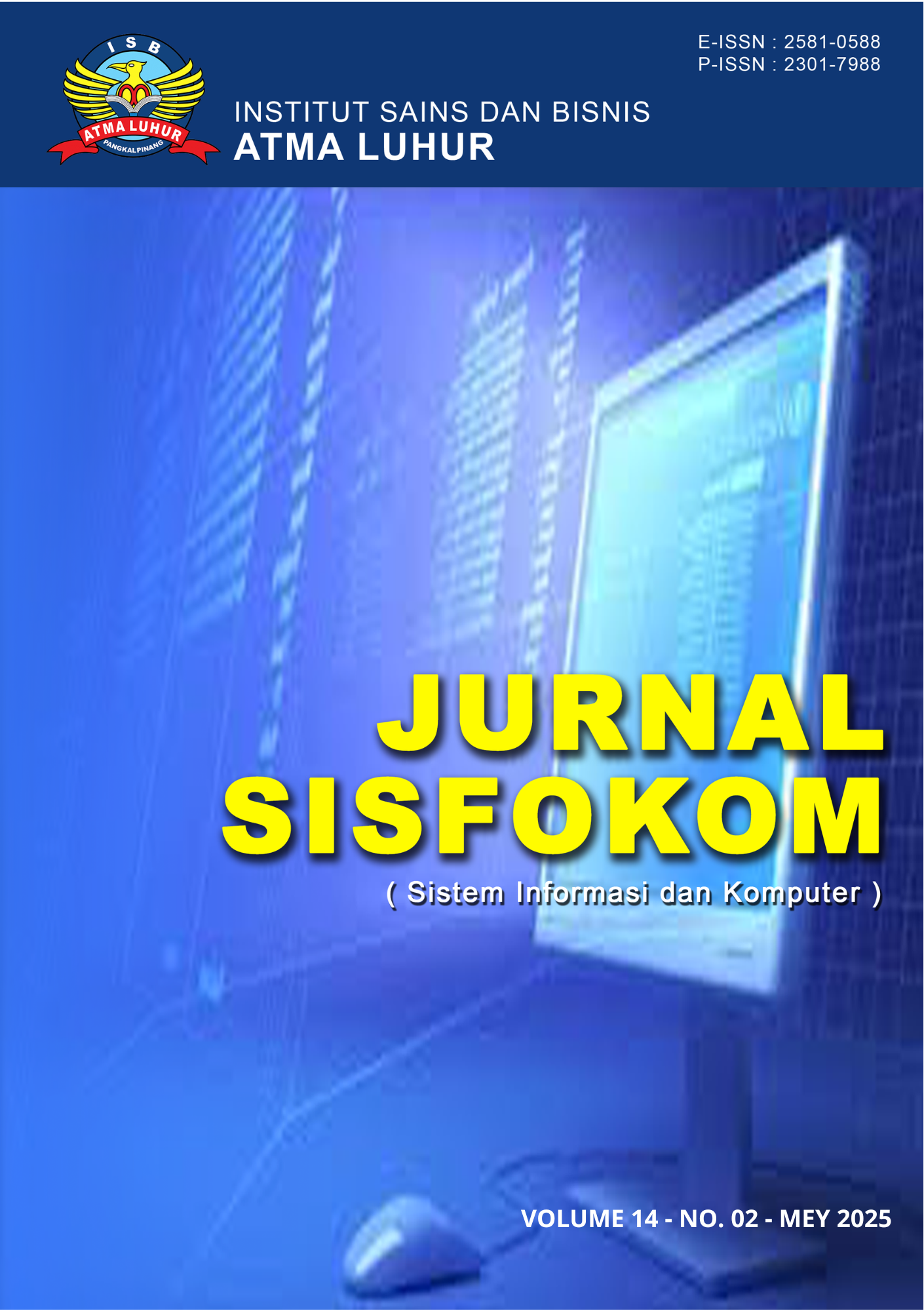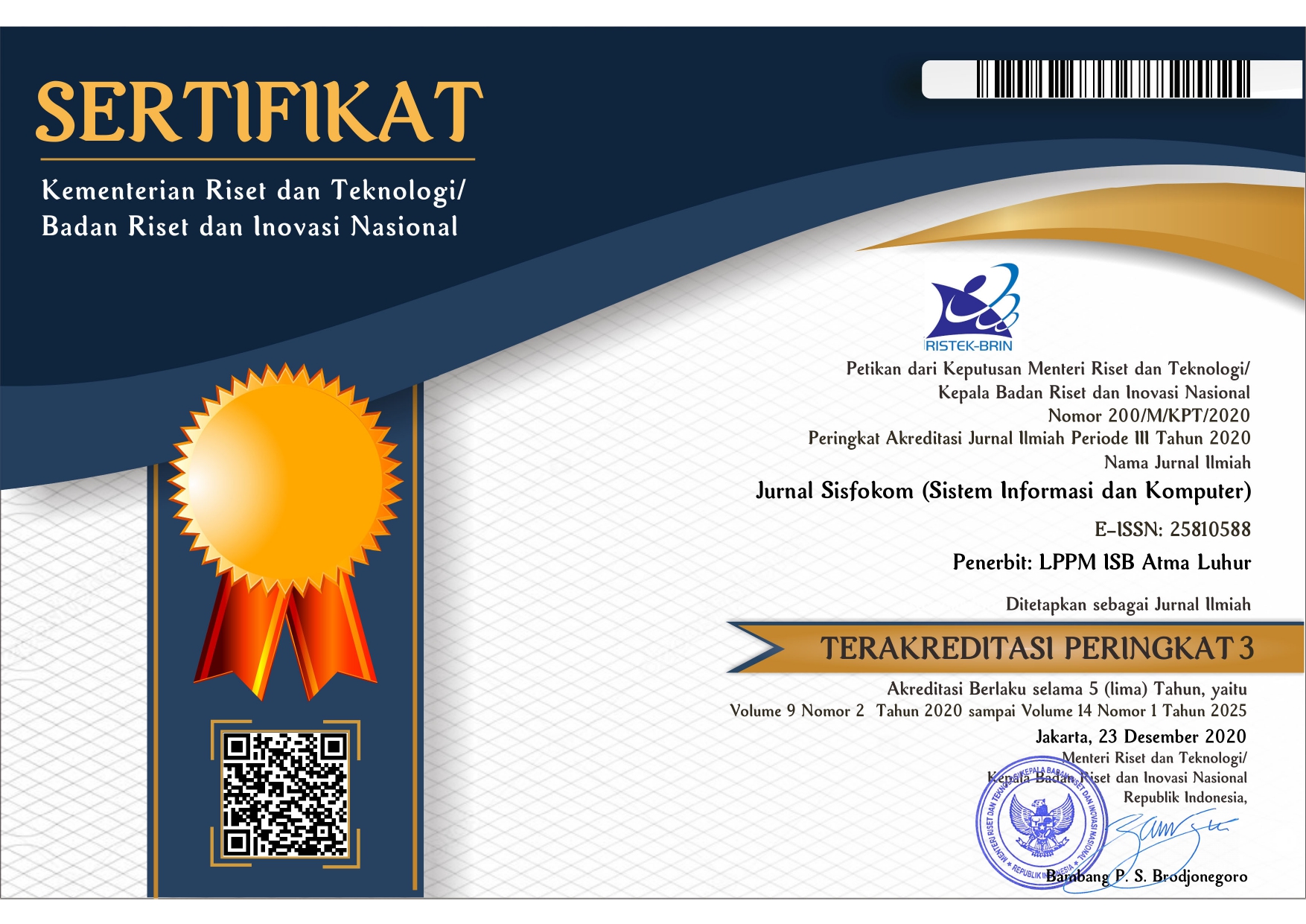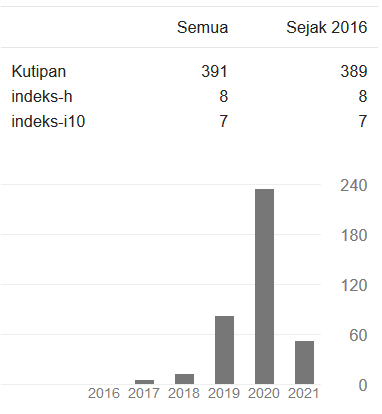Skincare Recommendation System Based on Facial Skin Type with Real-Time Weather Integration
DOI:
https://doi.org/10.32736/sisfokom.v14i2.2355Keywords:
Weather, Skin Type Classification, ResNet50, Product Recommendation, SkincareAbstract
Skin conditions can be significantly affected by unpredictable weather changes, creating the need for a solution that can provide personalized skincare product recommendations. This study presents the development of an AI-based skincare recommendation system that integrates skin type classification using Convolutional Neural Networks (CNN) with real-time weather data via the OpenWeatherMap API. The system consists of three main components: a ResNet50-based Skin Analyzer, a Weather Analyzer using the Decision Tree algorithm, and a Product Recommendation module. The image dataset is sourced from two Kaggle datasets: "Dry, Oily, and Normal Skin Types" and "Acne Dataset." The total dataset consists of 2,885 images, divided into four classes: Acne (549 images), Dry (652 images), Normal (884 images), and Oily (800 images). The dataset exhibits diversity in skin types, allowing for a more valid evaluation of the CNN model. The training and testing process involved splitting the data into training and testing sets, with augmentation applied to the training data to enhance the feature diversity across classes. Evaluation results show an average validation accuracy of 90.94% ± 0.60% with consistent performance. This system aids users in identifying their skin type and suggests appropriate skincare products based on current weather conditions. It is expected to contribute to the advancement of AI-driven personalization in the skincare industry.References
H. Hassani, E. S. Silva, S. Unger, M. TajMazinani, and S. Mac Feely, “Artificial Intelligence (AI) or Intelligence Augmentation (IA): What Is the Future?,” AI, vol. 1, no. 2, Jun. 2020, doi: 10.3390/ai1020008.
R. Peng, M. Ronnier Luo, Y. Zhu, X. Liu, and M. Pointer, “Preferred skin reproduction of different skin groups,” Vision Res., vol. 207, Jun. 2023, doi: 10.1016/j.visres.2023.108210.
“ZAP BEAUTY INDEX 2023 ZAP BEAUTY INDEX.”
A. Georgievskaya, T. Tlyachev, D. Danko, K. Chekanov, and H. Corstjens, “How artificial intelligence adopts human biases: the case of cosmetic skincare industry,” AI Ethics, Nov. 2023, doi: 10.1007/s43681-023-00378-2.
J. Lee and K. H. Kwon, “Skin health response to climate change weather tailored cosmetics using artificial intelligence,” Jun. 30, 2024, AME Publishing Company. doi: 10.21037/jmai-24-71.
J. Miryabbelli, M. Jayaram, S. A. Reddy, and K. B. Prakash, “SMART COSMETICS RECOMMENDATION SYSTEM BASED ON SKIN CONDITION USING ARTIFICIAL INTELLIGENCE,” 2024, [Online]. Available: https://www.researchgate.net/publication/381760096
J. Foster et al., “Quantifying the impact of heat on human physical work capacity; part III: the impact of solar radiation varies with air temperature, humidity, and clothing coverage,” Int. J. Biometeorol., vol. 66, no. 1, pp. 175–188, Jan. 2022, doi: 10.1007/s00484-021-02205-x.
M. Awni Ahmad Mahmoud, U. A. Badawi, W. Hassan, and Y. M. Alomari, “Evaluation of User Experience in Mobile Applications.” [Online]. Available: https://www.researchgate.net/publication/351935442
J. Lee, H. Yoon, S. Kim, C. Lee, J. Lee, and S. Yoo, “Deep learning-based skin care product recommendation: A focus on cosmetic ingredient analysis and facial skin conditions,” J. Cosmet. Dermatol., vol. 23, no. 6, pp. 2066–2077, Jun. 2024, doi: 10.1111/jocd.16218.
F. Erlangga and I. P. Sari, “Perancangan Sistem Untuk Merekomendasikan Produk Skincare Menggunakan Metode NLP,” Portal Ris. dan Inov. Sist. Perangkat Lunak, vol. 2, no. 4, pp. 1–11, Oct. 2024, doi: 10.59696/prinsip.v2i4.49.
Mohan Jadhav, Prasad Bhat, Kunal Thakare, and Prof. Komal Jadhav, “Symptom Checker Framework: Leveraging Machine Learning for Early Diagnosis in Healthcare Systems,” Int. J. Adv. Res. Sci. Commun. Technol., pp. 269–276, Nov. 2024, doi: 10.48175/IJARSCT-22443.
T. M. Daun, “330836-Implementasi-Transfer-Learning-Untuk-Ide-D90F6B20,” vol. 1, no. 6, pp. 672–679, 2020.
S. Dissanayake, “Dry, Oily, and Normal Skin Types,” Kaagle. Accessed: Feb. 18, 2025. [Online]. Available: https://www.kaggle.com/datasets/shakyadissanayake/dry-oily-and-normal-skin-types
N. Chaure, “Acne Dataset,” Kaagle. Accessed: Feb. 14, 2025. [Online]. Available: https://www.kaggle.com/datasets/nayanchaure/acne-dataset
A. Nawrocka, M. Nawrocki, and A. Kot, “Research study of image classification algorithms based on Convolutional Neural Networks,” Proc. 2023 24th Int. Carpathian Control Conf. ICCC 2023, pp. 299–302, 2023, doi: 10.1109/ICCC57093.2023.10178933.
M. W. P. Maduranga and D. Nandasena, “Mobile-Based Skin Disease Diagnosis System Using Convolutional Neural Networks (CNN),” Int. J. Image, Graph. Signal Process., vol. 14, no. 3, pp. 47–57, Jun. 2022, doi: 10.5815/ijigsp.2022.03.05.
M. R. Satria and J. Pardede, “Image Captioning Menggunakan Metode ResNet50 Dan Long Short-Term Memory,” J. Tera, vol. 2, no. 2, pp. 84–94, 2022, [Online]. Available: http://jurnal.undira.ac.id/index.php/jurnaltera/
N. A. Al-Humaidan and M. Prince, “A Classification of Arab Ethnicity Based on Face Image Using Deep Learning Approach,” IEEE Access, vol. 9, no. March, pp. 50755–50766, 2021, doi: 10.1109/ACCESS.2021.3069022.
H. Hendri, L. Hoki, V. Agusman, and D. Aryanto, “Penerapan Machine Learning Untuk Mengategorikan Sampah Plastik Rumah Tangga,” J. TIMES, vol. 10, no. 1, pp. 1–5, 2021, doi: 10.51351/jtm.10.1.2021645.
C. Baldermann, G. Laschewski, and J.-U. Grooß, “Impact of climate change on non-communicable diseases caused by altered UV radiation.,” J. Heal. Monit., vol. 8, no. Suppl 4, pp. 57–75, Sep. 2023, doi: 10.25646/11653.
H. Ku and W. Dong, “Face Recognition Based on MTCNN and Convolutional Neural Network,” Front. Signal Process., vol. 4, no. 1, pp. 37–42, 2020, doi: 10.22606/fsp.2020.41006.
E. Valverde, A. Caliwag, J. Kwon, and ..., “Optimization of Face Detection Based on MTCNN Using Automated Model Compression Method,” 한국통신학회 …, vol. 7, no. 8, pp. 456–464, 2021, doi: 10.6919/ICJE.202108.
Downloads
Published
Issue
Section
License

This work is licensed under a Creative Commons Attribution 4.0 International License.
The copyright of the article that accepted for publication shall be assigned to Jurnal Sisfokom (Sistem Informasi dan Komputer) and LPPM ISB Atma Luhur as the publisher of the journal. Copyright includes the right to reproduce and deliver the article in all form and media, including reprints, photographs, microfilms, and any other similar reproductions, as well as translations.
Jurnal Sisfokom (Sistem Informasi dan Komputer), LPPM ISB Atma Luhur, and the Editors make every effort to ensure that no wrong or misleading data, opinions or statements be published in the journal. In any way, the contents of the articles and advertisements published in Jurnal Sisfokom (Sistem Informasi dan Komputer) are the sole and exclusive responsibility of their respective authors.
Jurnal Sisfokom (Sistem Informasi dan Komputer) has full publishing rights to the published articles. Authors are allowed to distribute articles that have been published by sharing the link or DOI of the article. Authors are allowed to use their articles for legal purposes deemed necessary without the written permission of the journal with the initial publication notification from the Jurnal Sisfokom (Sistem Informasi dan Komputer).
The Copyright Transfer Form can be downloaded [Copyright Transfer Form Jurnal Sisfokom (Sistem Informasi dan Komputer).
This agreement is to be signed by at least one of the authors who have obtained the assent of the co-author(s). After submission of this agreement signed by the corresponding author, changes of authorship or in the order of the authors listed will not be accepted. The copyright form should be signed originally, and send it to the Editorial in the form of scanned document to sisfokom@atmaluhur.ac.id.









